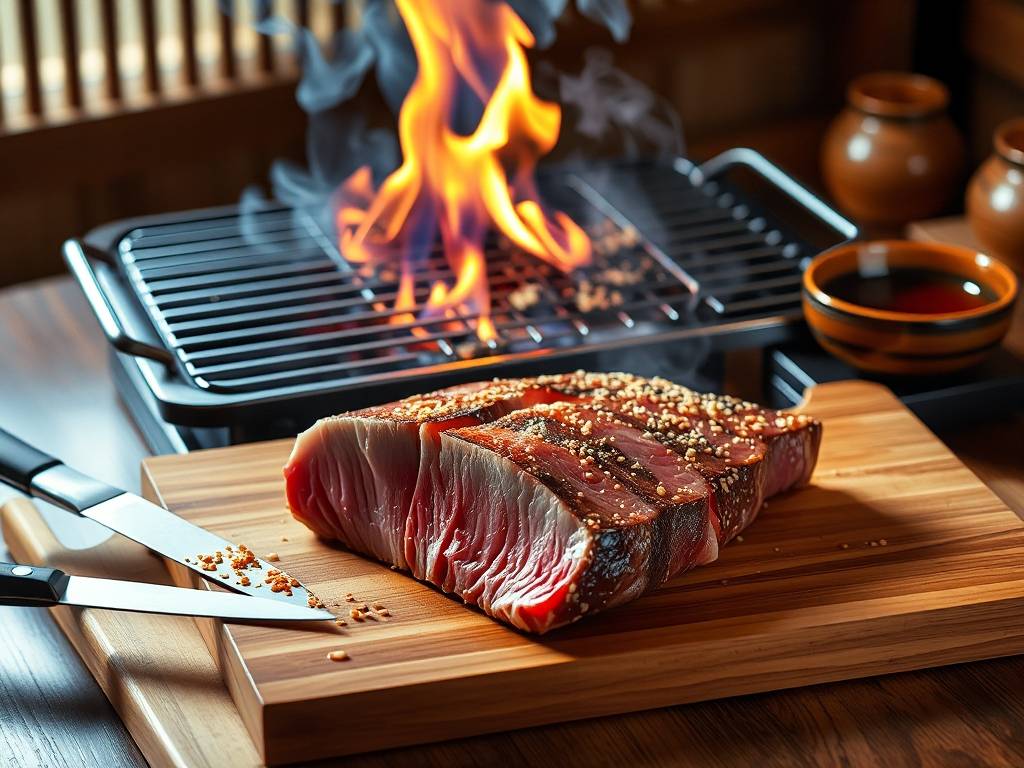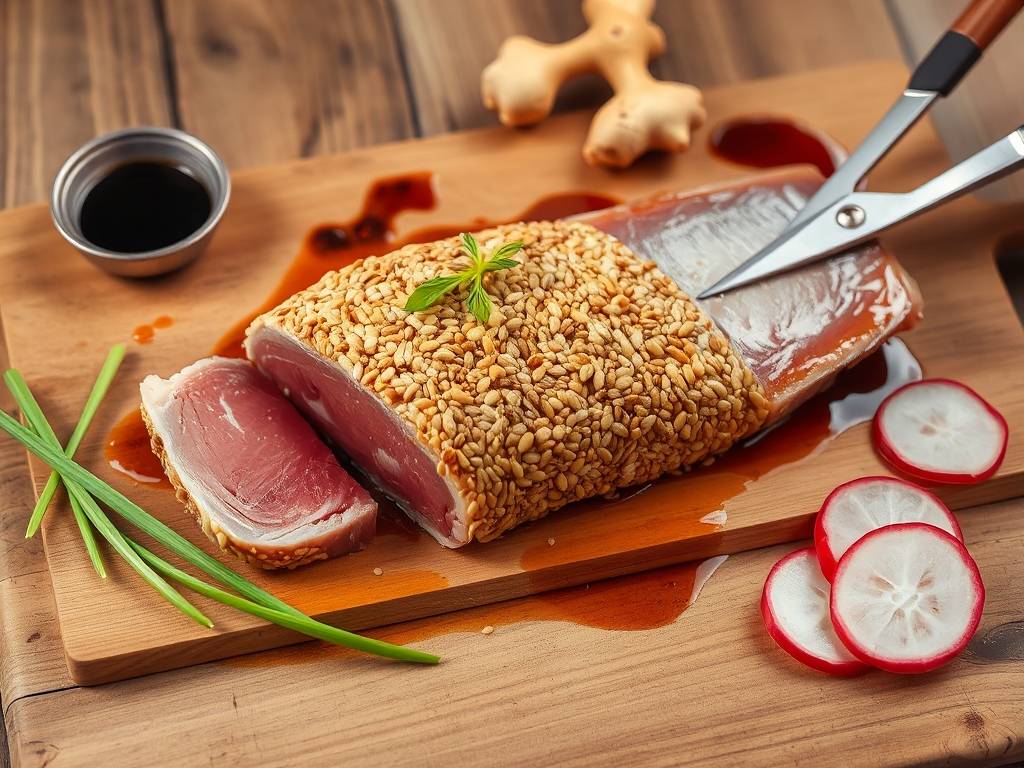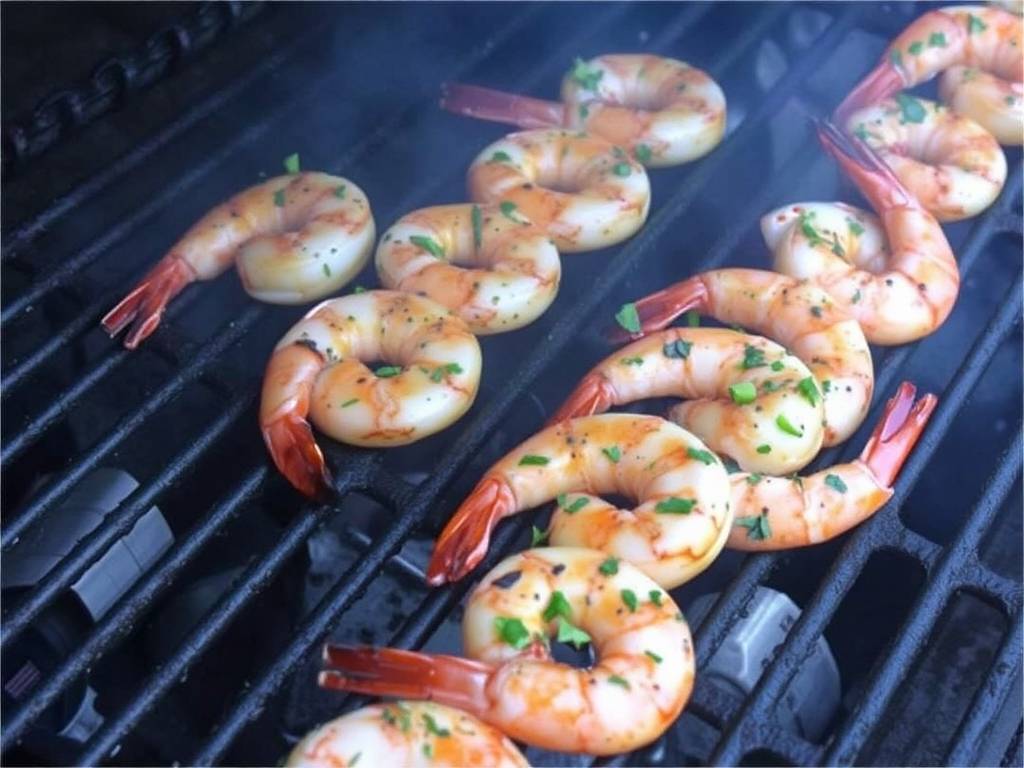The Art of Grilling Tuna with Sesame Crust and Soy: A Culinary Journey
Grilling is one of the most ancient and universally beloved methods of cooking, and when it comes to seafood, few dishes capture the essence of simplicity and sophistication quite like grilled tuna with a sesame crust and soy glaze. This dish is a perfect marriage of textures and flavors—the rich, meaty quality of the tuna, the nutty crunch of sesame seeds, and the savory-sweet depth of soy-based marinade. Whether you're an experienced home chef or a grilling novice, mastering this recipe will elevate your culinary repertoire and impress your guests with a restaurant-quality meal.
Selecting the Perfect Tuna

The foundation of any great grilled tuna dish is, unsurprisingly, the tuna itself. Not all tuna is created equal, and selecting the right cut is crucial. For grilling, opt for sushi-grade tuna steaks, typically cut from the loin. The most popular varieties include yellowfin (ahi) and bigeye tuna, both known for their firm texture and mild, clean flavor. When purchasing, look for steaks that are vibrant red or pink, with a glossy sheen and no signs of discoloration or strong fishy odor. The thickness of the steak is also important; aim for cuts that are at least one inch thick to ensure they hold up well on the grill without overcooking.
The Marinade: Balancing Flavors
A well-crafted marinade is the soul of this dish. The primary components are soy sauce, which provides umami and saltiness; citrus (usually lime or lemon juice) for acidity; sweet elements like honey or mirin to balance the salt; and aromatics such as garlic, ginger, and scallions for complexity.
A classic marinade for sesame-crusted tuna might include:
- ¼ cup soy sauce (or tamari for a gluten-free option)
- 2 tablespoons honey or brown sugar
- 1 tablespoon freshly squeezed lime juice
- 2 cloves garlic, minced
- 1 teaspoon grated fresh ginger
- 1 tablespoon sesame oil
Whisk these ingredients together in a shallow dish. Place the tuna steaks in the marinade, ensuring they are fully coated. Cover and refrigerate for 30 minutes to an hour. Marinating for too long can cause the acid in the citrus to "cook" the fish, resulting in a ceviche-like texture, which is not desirable for grilling. The goal is to infuse flavor without compromising the tuna's integrity.
Creating the Sesame Crust
The sesame crust is what gives this dish its signature crunch and visual appeal. You can use either black sesame seeds, white sesame seeds, or a combination of both for a striking contrast. Toasting the sesame seeds beforehand is highly recommended, as it enhances their nutty flavor. Simply place the seeds in a dry skillet over medium heat and toast for 2-3 minutes, shaking the pan frequently until they are fragrant and lightly golden.
After marinating, remove the tuna steaks and pat them dry with paper towels. This step is critical—excess moisture will prevent the sesame seeds from adhering properly. Spread the toasted sesame seeds on a plate and press each side of the tuna steak into the seeds, ensuring an even, generous coating. Gently press down to help the seeds stick.

Grilling to Perfection
Grilling tuna requires attention and precision. The high heat of the grill should sear the exterior quickly while leaving the interior rare to medium-rare, as overcooked tuna becomes dry and tough.
Preheat your grill to high heat (around 450-500°F or 230-260°C). Ensure the grates are clean and lightly oiled to prevent sticking. Place the sesame-crusted tuna steaks on the grill and cook for approximately 1.5 to 2 minutes per side for a rare center, or 2.5 to 3 minutes per side for medium-rare. Avoid moving the steaks excessively; allow them to develop a good sear and grill marks before flipping. Use a spatula to turn them gently to avoid dislodging the sesame crust.
For those who prefer their tuna more well-done, note that extending the cooking time much beyond 3 minutes per side risks compromising the texture. Tuna is best enjoyed when the center remains pink and tender.
Resting and Serving
Once grilled to your desired doneness, remove the tuna from the grill and let it rest for a couple of minutes. Resting allows the juices to redistribute, ensuring a moist and flavorful bite. Slice the tuna against the grain into ½-inch thick slices for an elegant presentation.
This dish pairs beautifully with a variety of sides. Consider serving it over a bed of jasmine rice or quinoa, accompanied by steamed edamame, stir-fried vegetables, or a light Asian-inspired slaw. A drizzle of extra soy glaze or a sprinkle of fresh cilantro and sliced scallions can add finishing touches.
Variations and Tips
- Spicy Kick: Add a teaspoon of sriracha or red pepper flakes to the marinade for a hint of heat.
- Different Nuts: While sesame seeds are traditional, you can experiment with crushed peanuts or almonds for a different crunch.
- Pan-Searing Option: If grilling isn’t an option, a hot cast-iron skillet with a bit of oil works wonderfully for achieving a similar sear.
- Sauce Enhancements: Reduce the marinade in a saucepan after removing the tuna to create a thicker glaze to serve on the side.
Conclusion
Grilling tuna with a sesame crust and soy marinade is more than just a recipe—it's an experience that engages the senses. The sizzle of the grill, the aroma of toasting sesame and soy, and the vibrant colors on the plate all contribute to a memorable meal. With attention to quality ingredients, marinating time, and grilling technique, you can create a dish that is both effortlessly elegant and deeply satisfying. So fire up the grill, and embark on a culinary journey that celebrates the timeless appeal of perfectly cooked tuna.






发表评论